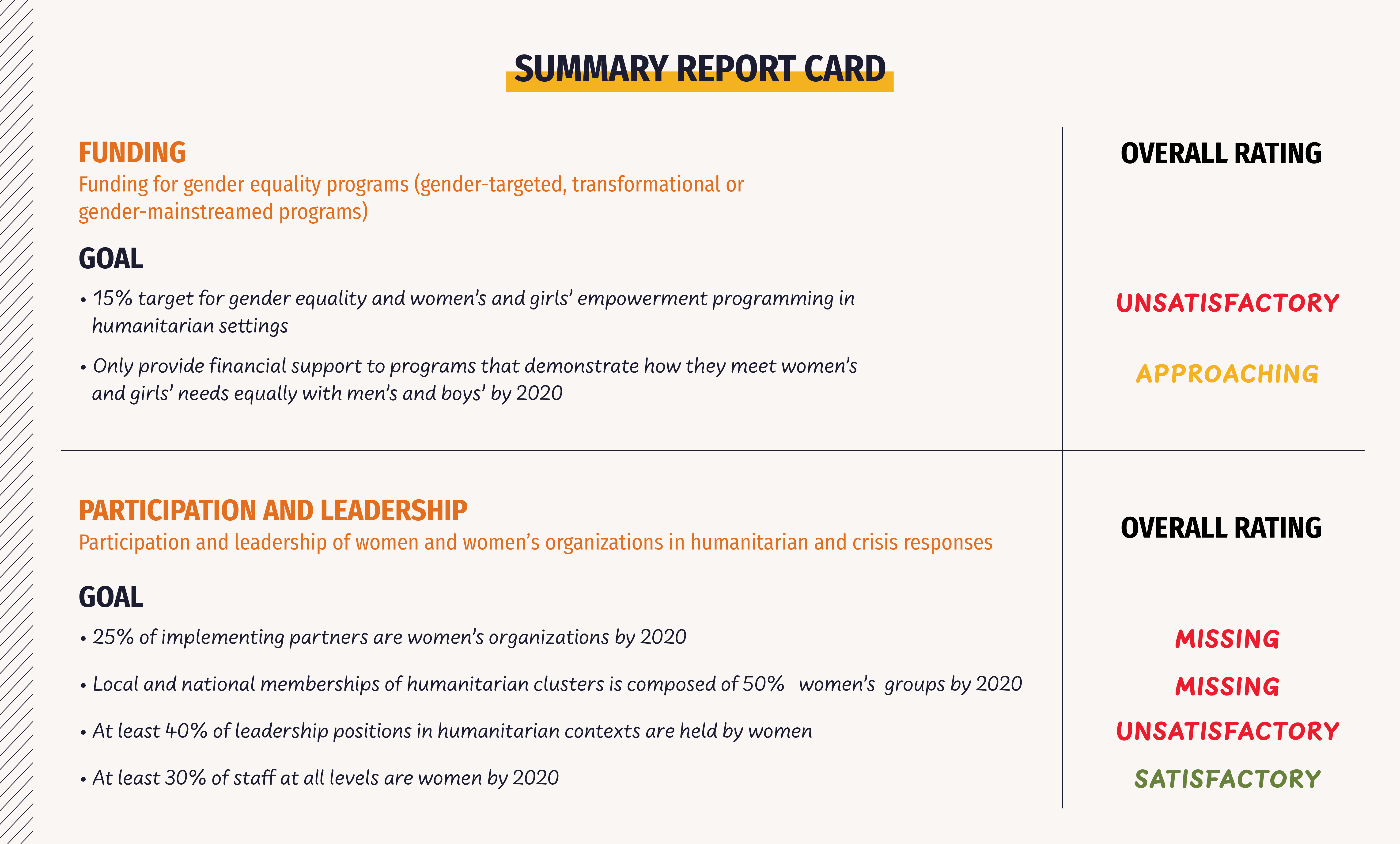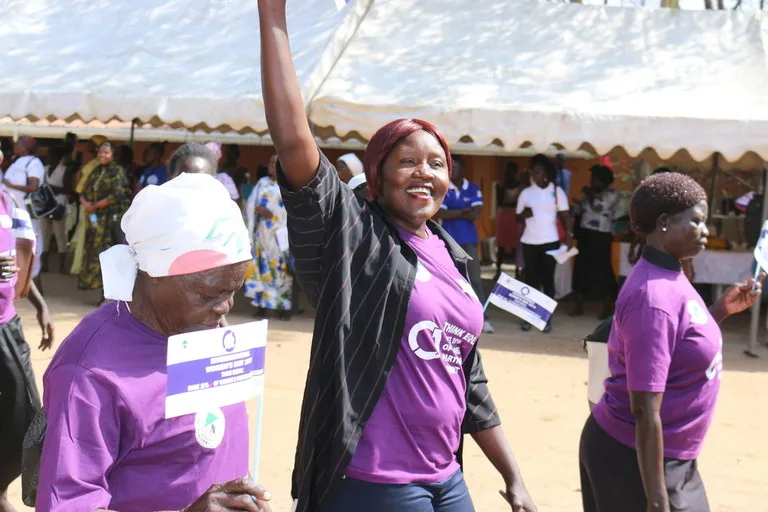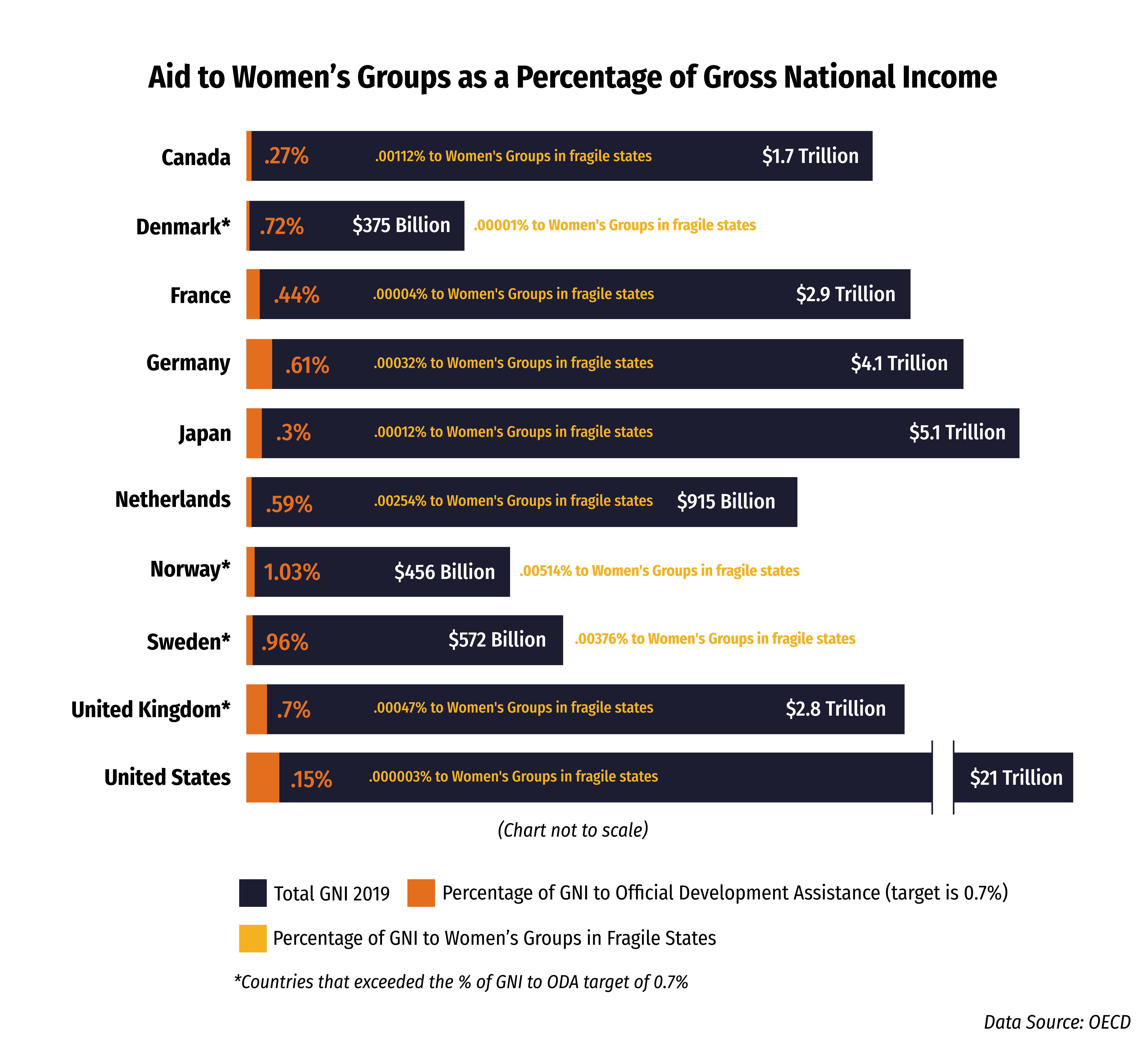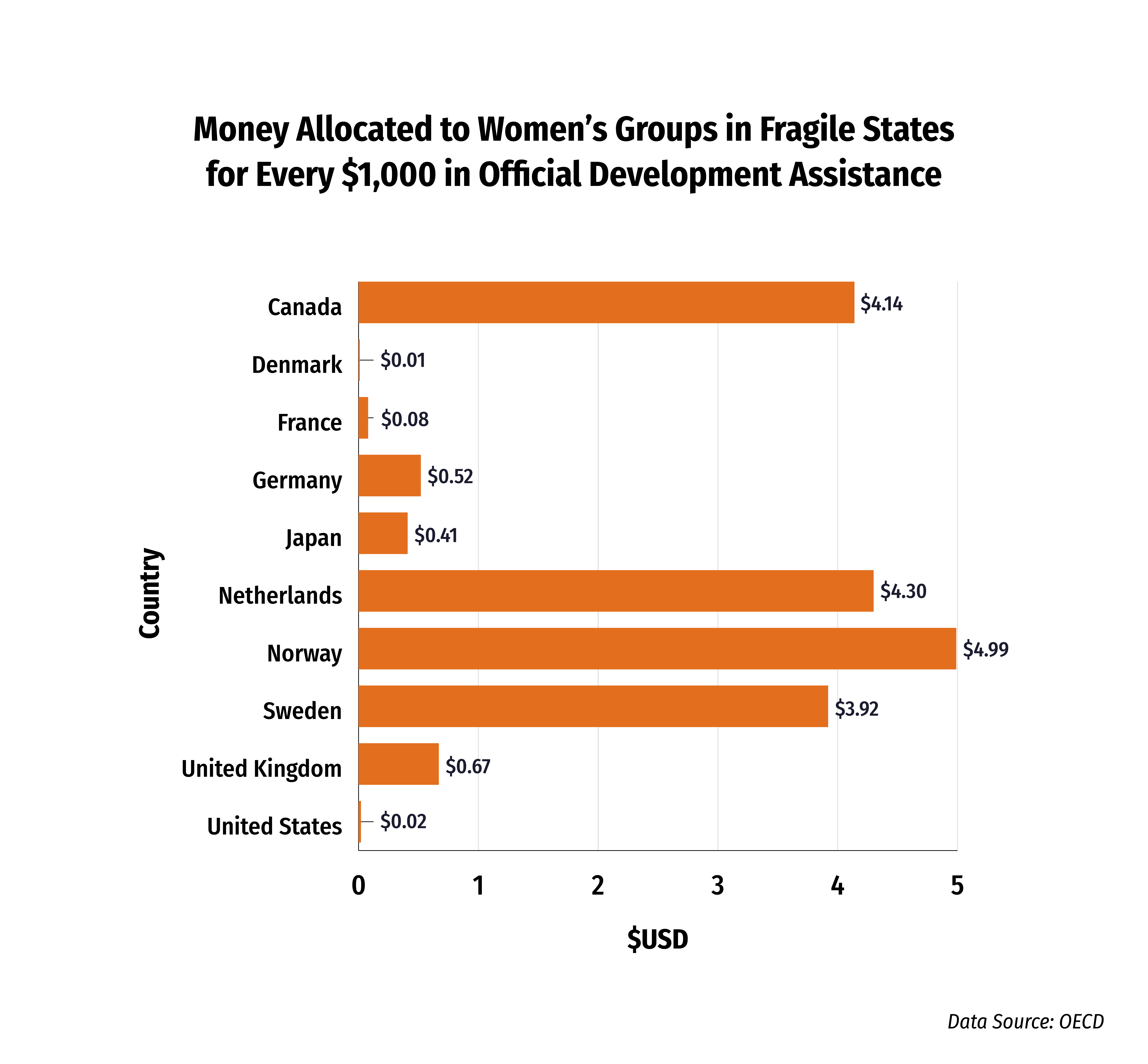“Time for a Better Bargain: How the Aid System Shortchanges Women and Girls in Crisis” assesses the top 11 donors and 5 UN agencies on three priority areas.

CARE report reveals how the aid system shortchanged women and girls in crisis.


In recent years, donor countries and agencies have engaged in unprecedented discussions and commitments to gender equality, from setting feminist development policies to passing UN resolutions on Women, Peace and Security. But despite the talk, the numbers tell a different story—one in which women and girls still get shortchanged.


When women lead, they're a force to be reckoned with.
This report uses benchmarks from the High-Level Roundtable on Women and Girls at the first-ever World Humanitarian Summit. CARE chose the most specific, relevant and measurable of the sample benchmarks that would genuinely lead to gender transformative change. These indicators reflect emerging global norms and standards around gender in humanitarian settings, and align to existing commitments rooted in the United Nations Women, Peace and Security Agenda, as well as Sustainable Development Goal 5 on gender equality and empowerment of all women and girls.
UN Agencies and wealthy donor countries fall short of adequately funding women’s groups when responding to crises in fragile and conflict-affected states. Despite modest increased funding to gender equality efforts since the Grand Bargain agreement adopted in the 2016 World Humanitarian Summit, women’s organizations remain severely underfunded. Most donors reviewed allocate only a fraction of 1% to directly funding women’s organizations.
Programs focused on women and girls in humanitarian crisis responses are routinely underfunded by donor countries. The average funding of humanitarian appeals is 61%. Yet programs that address gender-based violence, reproductive health and child protection are funded at 33%, 43% and 50%, respectively. To remedy this, donor countries must ensure at least 15% of all funding goes specifically to gender equality programming in humanitarian settings.
When a crisis hits, women and girls are affected differently than men and boys. Women are more likely to be displaced, subjected to gender-based violence, lose livelihoods, or go hungry in emergencies. To effectively respond to humanitarian crises, UN agencies and donor countries must guarantee that all programs in humanitarian settings account equally for the needs of women and girls and men and boys.
Women-led and women’s rights organizations must be included as partners because they typically know their communities best and can reach the most marginalized populations. Despite that fact, none of the UN agencies contacted for this report currently track data on how many of their implementing partners are women’s rights organizations or women-led organizations.
Humanitarian clusters, usually led by a UN agency and co-led by an international NGO, play critical coordination, leadership, and accountability roles in crisis response. Women’s voices and inputs are critical to mounting effective, inclusive crisis response. Still, cluster groups don’t prioritize (or at the very least track) representation of women’s rights and women-led organizations at the field cluster level.
Most UN Agencies have made impressive gains toward gender parity in influential humanitarian leadership positions. While women’s leadership in humanitarian contexts has been increasing—over 37% of UN Humanitarian Coordinators are women today, compared to 20% in 2010—progress has been uneven. Women must hold at least 40% of top posts at UN agencies if the international community seeks to lead by example on gender equal leadership.
All of the UN agencies with published information on staffing have well over 30% female employees. These staffing levels include headquarters and non-headquarters staff. Staffing levels are not broken down by crisis and non-crisis affected countries, which may skew the results in favor of agencies with a presence in more countries where they only implement development programs. Nonetheless, such gender parity reflects robust progress and impressive political will.
UN Agencies and wealthy donor countries fall short of adequately funding women’s groups when responding to crises in fragile and conflict-affected states. Despite modest increased funding to gender equality efforts since the Grand Bargain agreement adopted in the 2016 World Humanitarian Summit, women’s organizations remain severely underfunded. Most donors reviewed allocate only a fraction of 1% to directly funding women’s organizations.
Programs focused on women and girls in humanitarian crisis responses are routinely underfunded by donor countries. The average funding of humanitarian appeals is 61%. Yet programs that address gender-based violence, reproductive health and child protection are funded at 33%, 43% and 50%, respectively. To remedy this, donor countries must ensure at least 15% of all funding goes specifically to gender equality programming in humanitarian settings.
When a crisis hits, women and girls are affected differently than men and boys. Women are more likely to be displaced, subjected to gender-based violence, lose livelihoods, or go hungry in emergencies. To effectively respond to humanitarian crises, UN agencies and donor countries must guarantee that all programs in humanitarian settings account equally for the needs of women and girls and men and boys.
Women-led and women’s rights organizations must be included as partners because they typically know their communities best and can reach the most marginalized populations. Despite that fact, none of the UN agencies contacted for this report currently track data on how many of their implementing partners are women’s rights organizations or women-led organizations.
Humanitarian clusters, usually led by a UN agency and co-led by an international NGO, play critical coordination, leadership, and accountability roles in crisis response. Women’s voices and inputs are critical to mounting effective, inclusive crisis response. Still, cluster groups don’t prioritize (or at the very least track) representation of women’s rights and women-led organizations at the field cluster level.
Most UN Agencies have made impressive gains toward gender parity in influential humanitarian leadership positions. While women’s leadership in humanitarian contexts has been increasing—over 37% of UN Humanitarian Coordinators are women today, compared to 20% in 2010—progress has been uneven. Women must hold at least 40% of top posts at UN agencies if the international community seeks to lead by example on gender equal leadership.
All of the UN agencies with published information on staffing have well over 30% female employees. These staffing levels include headquarters and non-headquarters staff. Staffing levels are not broken down by crisis and non-crisis affected countries, which may skew the results in favor of agencies with a presence in more countries where they only implement development programs. Nonetheless, such gender parity reflects robust progress and impressive political will.
For this report, CARE drew on the most up-to-date information made publicly available by donors and UN agencies to commonly used, credible, multilateral databases. To analyze donor funding, CARE used the Organization for Economic Co-operation and Development (OECD) database, which requires OECD member states to report on gender equality programming and on funding to women’s rights organizations, movements and ministries. For UN agencies, CARE analyzed funding data published on the International Aid Transparency Initiative (IATI) digital portal, which categorizes information using the same codes and criteria as the OECD, and considered the basis for a common standard for publishing data on humanitarian funding.
There is currently no universally reliable, systemic, harmonized database available for the data sought on resourcing and supporting women-led crisis response. While some databases exist, most track individual agencies or donors with varying approaches and coding, rendering them unfit for the purpose of cross-actor comparison or tracking funding in aggregate.
Donor countries were assessed on their reported levels of resourcing to women’s rights organizations, women-led organizations and women’s institutions in crisis-affected areas and funding for gender-equality and empowerment of women and girls programming.
Indicator 1
Increase Funding to Women’s Groups to 4% by 2020
Unsatisfactory
Indicator 2
Allocate 15% of Funding to Gender Equality Programs
Unsatisfactory
Indicator 3
Account Equally for the Needs of Women and Girls
Satisfactory
Indicator 1
Increase Funding to Women’s Groups to 4% by 2020
Unsatisfactory
Indicator 2
Allocate 15% of Funding to Gender Equality Programs
Unsatisfactory
Indicator 3
Account Equally for the Needs of Women and Girls
Satisfactory
Indicator 1
Increase Funding to Women’s Groups to 4% by 2020
Unsatisfactory
Indicator 2
Allocate 15% of Funding to Gender Equality Programs
Unsatisfactory
Indicator 3
Account Equally for the Needs of Women and Girls
Unsatisfactory
Indicator 1
Increase Funding to Women’s Groups to 4% by 2020
Unsatisfactory
Indicator 2
Allocate 15% of Funding to Gender Equality Programs
Unsatisfactory
Indicator 3
Account Equally for the Needs of Women and Girls
Unsatisfactory
Indicator 1
Increase Funding to Women’s Groups to 4% by 2020
Unsatisfactory
Indicator 2
Allocate 15% of Funding to Gender Equality Programs
Unsatisfactory
Indicator 3
Account Equally for the Needs of Women and Girls
Unsatisfactory
Indicator 1
Increase Funding to Women’s Groups to 4% by 2020
Unsatisfactory
Indicator 2
Allocate 15% of Funding to Gender Equality Programs
Unsatisfactory
Indicator 3
Account Equally for the Needs of Women and Girls
Unsatisfactory
Indicator 1
Increase Funding to Women’s Groups to 4% by 2020
Unsatisfactory
Indicator 2
Allocate 15% of Funding to Gender Equality Programs
Unsatisfactory
Indicator 3
Account Equally for the Needs of Women and Girls
Unsatisfactory
Indicator 1
Increase Funding to Women’s Groups to 4% by 2020
Unsatisfactory
Indicator 2
Allocate 15% of Funding to Gender Equality Programs
Unsatisfactory
Indicator 3
Account Equally for the Needs of Women and Girls
Unsatisfactory
Indicator 1
Increase Funding to Women’s Groups to 4% by 2020
Unsatisfactory
Indicator 2
Allocate 15% of Funding to Gender Equality Programs
Approaching
Indicator 3
Account Equally for the Needs of Women and Girls
Satisfactory
Indicator 1
Increase Funding to Women’s Groups to 4% by 2020
Unsatisfactory
Indicator 2
Allocate 15% of Funding to Gender Equality Programs
Approaching
Indicator 3
Account Equally for the Needs of Women and Girls
Satisfactory
Indicator 1
Increase Funding to Women’s Groups to 4% by 2020
Satisfactory
Indicator 2
Allocate 15% of Funding to Gender Equality Programs
Unsatisfactory
Indicator 3
Account Equally for the Needs of Women and Girls
Satisfactory
Indicator 1
Increase Funding to Women’s Groups to 4% by 2020
Satisfactory
Indicator 2
Allocate 15% of Funding to Gender Equality Programs
Unsatisfactory
Indicator 3
Account Equally for the Needs of Women and Girls
Satisfactory
Indicator 1
Increase Funding to Women’s Groups to 4% by 2020
Approaching
Indicator 2
Allocate 15% of Funding to Gender Equality Programs
Unsatisfactory
Indicator 3
Account Equally for the Needs of Women and Girls
Approaching
Indicator 1
Increase Funding to Women’s Groups to 4% by 2020
Approaching
Indicator 2
Allocate 15% of Funding to Gender Equality Programs
Unsatisfactory
Indicator 3
Account Equally for the Needs of Women and Girls
Approaching
Indicator 1
Increase Funding to Women’s Groups to 4% by 2020
Unsatisfactory
Indicator 2
Allocate 15% of Funding to Gender Equality Programs
Unsatisfactory
Indicator 3
Account Equally for the Needs of Women and Girls
Satisfactory
Indicator 1
Increase Funding to Women’s Groups to 4% by 2020
Unsatisfactory
Indicator 2
Allocate 15% of Funding to Gender Equality Programs
Unsatisfactory
Indicator 3
Account Equally for the Needs of Women and Girls
Satisfactory
Indicator 1
Increase Funding to Women’s Groups to 4% by 2020
Unsatisfactory
Indicator 2
Allocate 15% of Funding to Gender Equality Programs
Unsatisfactory
Indicator 3
Account Equally for the Needs of Women and Girls
Approaching
Indicator 1
Increase Funding to Women’s Groups to 4% by 2020
Unsatisfactory
Indicator 2
Allocate 15% of Funding to Gender Equality Programs
Unsatisfactory
Indicator 3
Account Equally for the Needs of Women and Girls
Approaching
Indicator 1
Increase Funding to Women’s Groups to 4% by 2020
Unsatisfactory
Indicator 2
Allocate 15% of Funding to Gender Equality Programs
Unsatisfactory
Indicator 3
Account Equally for the Needs of Women and Girls
Unsatisfactory
Indicator 1
Increase Funding to Women’s Groups to 4% by 2020
Unsatisfactory
Indicator 2
Allocate 15% of Funding to Gender Equality Programs
Unsatisfactory
Indicator 3
Account Equally for the Needs of Women and Girls
Unsatisfactory
Indicator 1
Increase Funding to Women’s Groups to 4% by 2020
Unsatisfactory
Indicator 2
Allocate 15% of Funding to Gender Equality Programs
Unsatisfactory
Indicator 3
Account Equally for the Needs of Women and Girls
Unsatisfactory
Indicator 1
Increase Funding to Women’s Groups to 4% by 2020
Unsatisfactory
Indicator 2
Allocate 15% of Funding to Gender Equality Programs
Unsatisfactory
Indicator 3
Account Equally for the Needs of Women and Girls
Unsatisfactory
UN Agencies were assessed on resourcing to women’s rights organizations, women-led organizations and women’s institutions in crisis-affected areas; funding for gender equality and empowerment of women’s and girls’ programming; and inclusion of women and women’s organizations in leadership and equal participation in humanitarian responses and crises.
Indicator 1
Increase Funding to Women’s Groups to 4% by 2020
Approaching
Indicator 2
Allocate 15% of Funding to Gender Equality Programs
Unsatisfactory
Indicator 3
Account Equally for the Needs of Women and Girls
Satisfactory
Indicator 4
Include Women’s Organizations as 25% of Implementing Partners
Missing
Indicator 6
Advance Gender Parity in Humanitarian UN Leadership
Unsatisfactory
Indicator 7
Women Should Make Up At Least 30% of UN Staff
Satisfactory
Indicator 1
Increase Funding to Women’s Groups to 4% by 2020
Approaching
Indicator 2
Allocate 15% of Funding to Gender Equality Programs
Unsatisfactory
Indicator 3
Account Equally for the Needs of Women and Girls
Satisfactory
Indicator 4
Include Women’s Organizations as 25% of Implementing Partners
Missing
Indicator 6
Advance Gender Parity in Humanitarian UN Leadership
Unsatisfactory
Indicator 7
Women Should Make Up At Least 30% of UN Staff
Satisfactory
Indicator 1
Increase Funding to Women’s Groups to 4% by 2020
Satisfactory
Indicator 2
Allocate 15% of Funding to Gender Equality Programs
Missing
Indicator 3
Account Equally for the Needs of Women and Girls
Missing
Indicator 4
Include Women’s Organizations as 25% of Implementing Partners
Missing
Indicator 6
Advance Gender Parity in Humanitarian UN Leadership
Satisfactory
Indicator 7
Women Should Make Up At Least 30% of UN Staff
Satisfactory
Indicator 1
Increase Funding to Women’s Groups to 4% by 2020
Satisfactory
Indicator 2
Allocate 15% of Funding to Gender Equality Programs
Missing
Indicator 3
Account Equally for the Needs of Women and Girls
Missing
Indicator 4
Include Women’s Organizations as 25% of Implementing Partners
Missing
Indicator 6
Advance Gender Parity in Humanitarian UN Leadership
Satisfactory
Indicator 7
Women Should Make Up At Least 30% of UN Staff
Satisfactory
Indicator 1
Increase Funding to Women’s Groups to 4% by 2020
Missing
Indicator 2
Allocate 15% of Funding to Gender Equality Programs
Missing
Indicator 3
Account Equally for the Needs of Women and Girls
Missing
Indicator 4
Include Women’s Organizations as 25% of Implementing Partners
Missing
Indicator 6
Advance Gender Parity in Humanitarian UN Leadership
Unsatisfactory
Indicator 7
Women Should Make Up At Least 30% of UN Staff
Satisfactory
Indicator 1
Increase Funding to Women’s Groups to 4% by 2020
Missing
Indicator 2
Allocate 15% of Funding to Gender Equality Programs
Missing
Indicator 3
Account Equally for the Needs of Women and Girls
Missing
Indicator 4
Include Women’s Organizations as 25% of Implementing Partners
Missing
Indicator 6
Advance Gender Parity in Humanitarian UN Leadership
Unsatisfactory
Indicator 7
Women Should Make Up At Least 30% of UN Staff
Satisfactory
Indicator 1
Increase Funding to Women’s Groups to 4% by 2020
Approaching
Indicator 2
Allocate 15% of Funding to Gender Equality Programs
Satisfactory
Indicator 3
Account Equally for the Needs of Women and Girls
Satisfactory
Indicator 4
Include Women’s Organizations as 25% of Implementing Partners
Missing
Indicator 6
Advance Gender Parity in Humanitarian UN Leadership
Satisfactory
Indicator 7
Women Should Make Up At Least 30% of UN Staff
Satisfactory
Indicator 1
Increase Funding to Women’s Groups to 4% by 2020
Approaching
Indicator 2
Allocate 15% of Funding to Gender Equality Programs
Satisfactory
Indicator 3
Account Equally for the Needs of Women and Girls
Satisfactory
Indicator 4
Include Women’s Organizations as 25% of Implementing Partners
Missing
Indicator 6
Advance Gender Parity in Humanitarian UN Leadership
Satisfactory
Indicator 7
Women Should Make Up At Least 30% of UN Staff
Satisfactory
Indicator 1
Increase Funding to Women’s Groups to 4% by 2020
Missing
Indicator 2
Allocate 15% of Funding to Gender Equality Programs
Missing
Indicator 3
Account Equally for the Needs of Women and Girls
Missing
Indicator 4
Include Women’s Organizations as 25% of Implementing Partners
Missing
Indicator 6
Advance Gender Parity in Humanitarian UN Leadership
Unsatisfactory
Indicator 7
Women Should Make Up At Least 30% of UN Staff
Satisfactory
Indicator 1
Increase Funding to Women’s Groups to 4% by 2020
Missing
Indicator 2
Allocate 15% of Funding to Gender Equality Programs
Missing
Indicator 3
Account Equally for the Needs of Women and Girls
Missing
Indicator 4
Include Women’s Organizations as 25% of Implementing Partners
Missing
Indicator 6
Advance Gender Parity in Humanitarian UN Leadership
Unsatisfactory
Indicator 7
Women Should Make Up At Least 30% of UN Staff
Satisfactory
Six of the seven indicators in this report are relevant to CARE and not just donors and UN agencies. CARE funds women’s rights and women-led organizations, has implementing partners, aspires to gender-transformative programming and has thousands of staff working in crisis-affected countries around the world.
Indicator 1
Increase Funding to Women’s Groups to 4% by 2020
Missing
Indicator 2
Allocate 15% of Funding to Gender Equality Programs
Satisfactory
Indicator 3
Account Equally for the Needs of Women and Girls
Satisfactory
Indicator 4
Include Women’s Organizations as 25% of Implementing Partners
Satisfactory
Indicator 6
Advance Gender Parity in Humanitarian Leadership
Unsatisfactory
Indicator 7
Women Should Make Up At Least 30% of Staff
Satisfactory
Indicator 1
Increase Funding to Women’s Groups to 4% by 2020
Missing
Indicator 2
Allocate 15% of Funding to Gender Equality Programs
Satisfactory
Indicator 3
Account Equally for the Needs of Women and Girls
Satisfactory
Indicator 4
Include Women’s Organizations as 25% of Implementing Partners
Satisfactory
Indicator 6
Advance Gender Parity in Humanitarian Leadership
Unsatisfactory
Indicator 7
Women Should Make Up At Least 30% of Staff
Satisfactory
We walk the talk. We hold major aid actors to account on gender equality commitments. We galvanize action on funding and participation of women in leading crisis response.
As part of the aid system, we call on donors, UN agencies and fellow INGOs to:
Now more than ever, funding and influence must flow into women- and girls-led crisis response, for effective, long-lasting, intergenerational impact. Please sign our global petition.
Women and girls know best what they need in crises, yet they are often severely under resourced and excluded from decisions that impact them.
Sign the PetitionAs an example of direct quality funding to women and girl-led efforts, Embark, an initiative of CARE, is a collective of members and activist advisors that creates flexible grants, lasting relationships, and distributes time and skills to women and girl-led organizations and leadership.
Learn more about EmbarkFootnotes
Indicator 2
For this indicator, CARE has analyzed OECD data which is marked as “gender principal” as a proportion of humanitarian expenditure. According to OECD criteria, projects should be marked gender principal where “gender equality is the main objective of the project/program and is fundamental in its design and expected results. The project/program would not have been undertaken without this gender equality objective.”47
*CARE used 2018 OECD data for donors, except those marked with a single asterisk in the table — Canada, Germany, Norway and Sweden — which are based on updated 2019 OECD data. CARE used IATI 2019 data for UN agencies. IATI and OECD use the same coding and definitions.
**This number illustrates the potential discrepancy between reporting to a public database, such as IATI used in this report and UN reports, as well as variance due to IATI’s coding of “humanitarian activity” which in some situations may be more limited in scope and scale compared to broader funding to fragile states. For example, UNDP notes that based on its internal database, its spending on Gender Equality and Women’s Empowerment programming in fragile states is 9.6% of total program spending in those countries, an increase from 7.7% in 2018. UNFPA stated that 15.1% of their programs in 2019 were gender targeted, and 94.6% either targeted or mainstreamed, although this is not disaggregated by crisis and non-crisis contexts.48
Indicator 3
Under OECD coding, such funding includes programs that promote gender equality as their core objective “gender principal” (see above) and those that consider “gender equality is an important and deliberate objective, but not the principal reason for undertaking the project/program” (“gender significant”).56 IATI and OECD use the same coding and definitions.
*CARE used 2018 OECD data for donors, except those marked with a single asterisk (*) in the table — Canada, Germany, Norway, Sweden — which are based on updated 2019 OECD data. CARE used IATI 2019 data for UN agencies. Note that IATI data is updated on an ongoing basis.
**Note that the Directorate General of European Civil Protection and Humanitarian Aid Operations (ECHO), the principal European institution for EU humanitarian relief, has a different gender analysis of its funding. A report published this year on the implementation of its Gender Marker found that in “2016 and 2017, 89% of all DG ECHO-funded actions integrated gender and age considerations either ‘strongly’ (mark ‘2’) or ‘to a certain extent’ (mark ‘1’).”57